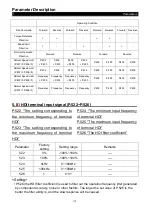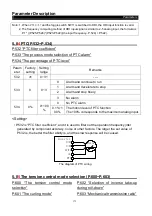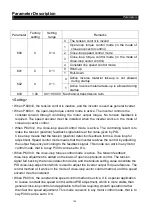
Parameter Description
Parameters
192
635
0
0~60000mm
Material width
636
0.0%
0.0%~50.0%
Friction compensation coefficient
<Setting>
• When the tension control adopts the open loop torque mode, during the system
acceleration/deceleration, additional torque shall be provided to overcome the rotation
inertia of the whole system. Otherwise, too small tension upon wind-up acceleration and
too large tension upon deceleration, or too large tension upon roll-down acceleration and
too small tension upon deceleration will be caused.
• For the instruction of P.631 and P.632, please refer to the instruction part of P.301=4.
• P.633 is used to set the mechanical inertia compensation coefficient. It is used to
compensate the rotation inertia of the system, including inertia of the motor, rotation
system and the shaft. Such inertias are fixed and independent of the curling radius. This
parameter can be obtained automatically by the system inertia self learning or manually
set based on the actual working situation.
• P.634 and P.635 are relevant to the material inertia compensation. The inverter will
automatically calculate the material inertia compensation value according to the
parameter and the curling radius.
• P.636 is used to set the friction compensation coefficient. Take wind-up as an example.
Because of the frictional resistance, the material tension reduces, which is more obvious
upon small roll, and the tension will be nonlinear. This situation can be improved by
setting the parameter.
5.9
4
Alarm History Clear (P.996)
P.996 “Alarm history clear”
● Once P.996 is read-out (after reading out the parameter, the screen will display
)
and rewrite it. All the abnormal record will be erased.
5.9
5
Inverter Reset (P.997)
P.997 “Inverter reset”
● Once P.997 is read-out (after the read-out, the screen will display
) and rewritten-in,
the inverter is reset. After resetting the inverter, the values of the two relays, “electronic
thermal relay” and “IGBT module thermal relay”, will be set to zero.






























